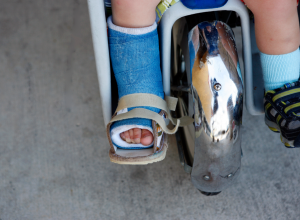
Casts and Splints
Casts and splints are devices that help protect and support sprained or broken limbs during the body’s healing process. They are sometimes also used after surgery to assist in healing.
A doctor will typically realign the fractured bones and/or set the injured soft tissue in its proper place before casting, after which the cast holds the pieces together in the right position and reduces pain, swelling and muscle spasms.
The Difference Between Casts and Splints
Casts
Each and every cast is custom made to fit a person’s body, as they must properly form to the shape of a fractured or injured limb to provide the best support. Casts are made from either plaster or fiberglass, two types of tough, supportive material that can be shaped.
Fiberglass casts are typically stronger than plaster casts. Other advantages over plaster casts include they’re lighter, less sensitive to water and more “see through” during x-rays, meaning the doctor or orthopaedist can better observe bone healing and whether or not a bone fracture is fusing together in the correct way. One advantage plaster casts have, however, is that they’re typically much less expensive than their fiberglass counterparts.
Splints
A splint, sometimes called a half cast, is slightly less supportive than traditional plaster or fiberglass casts, but the advantage of a splint is that it can more easily be adjusted to accommodate possible swelling. Some splints are custom-fit, but the majority of splints are ready-made and adjustable via Velcro straps.
Splints are often used for injuries that create excessive swelling. Initially, a splint is used as an adjustable method of bone or sprain support, followed by application of a traditional cast once the swelling subsides. Conversely, sometimes splints are used toward the end of casting therapy, when swelling subsides and the cast becomes “too big.” A splint can be used at this point, especially if physical therapy is involved.
Bone Healing: How Long Must A Cast Or Splint Be Worn?
Bone healing time greatly varies from person to person, with things like age, diet and physical health being great influencers. But orthopaedic specialists estimate that it takes anywhere from four to ten weeks for cast-related injuries like bone fractures and sprains to heal (Note: It usually takes six to eight weeks for a healthy adult to heal, less for a child to heal, and more time for very sick or elderly people as well as people who don’t properly take care of their casts).
How To Care For Casts and Splints
Properly taking care of your cast or splint will ensure the device stays in good condition and fully supports your injured limb while it heals. If a cast or a splint isn’t take care of (for instance, it gets wet, cut or misshapen), your body may take longer to heal and the cast or splint must be worn longer. Here are a few tips for keeping your cast or splint in good condition during the entirety of your ordeal:
Keep Your Cast or Splint Dry: Any type of moisture can weaken plaster and the padding used in both plaster and fiberglass casts. Not only does this reduce the cast’s stability (which slows your bones’ healing process and increases the risk that the fracture will heal incorrectly), the moisture can soak into the inner padding of the cast and cause major skin irritation. Always wrap your cast in several layers of plastic or waterproof material before bathing or taking a shower, and never submerge your cast or place it under running water — no matter how waterproof your cast wrapping may be. And if your cast does get wet, use a blow dryer set to a cool (not warm or hot) setting to help dry the material. And be sure to call your doctor, as he or she can help you determine if the cast or splint is still suitable for proper bone healing.
Handle Itching The Correct Way: Because casts must be worn for weeks, a patient is bound to feel a bit of itching under the plaster or fiberglass. It’s important that you do not shove coat hangers, rulers or other objects under the cast to relieve an itching limb, as it could create skin scrapes and scratches that can easily become infected. Instead, ask your doctor about anti-itch sprays designed specifically to reduce itching caused by casts.
Avoid Dirt, Lotion and Powder: Do your best to keep your cast clean by avoiding dirt and sand. Also try to keep lotions and powders away from the edges of your cast, as they can begin to create a smelly buildup and weaken the strength of your cast.
Resist Trimming Or Cutting The Cast: Never cut off or trim rough edges of a cast without first asking your orthopaedist or surgeon. Similarly, do not pull out any loose padding.
Regularly Inspect The Cast And Surrounding Skin: During the entirety of wearing a cast, the patient should regularly observe the skin surrounding the cast and notify his or her orthopedic specialist if the skin appears red, raw or infected. The patient should also inspect the cast for cracks or soft spots and notify his or her doctor at the first sign of these problems.
Learn Important Warning Signs: There are several signs and symptoms you should never ignore while wearing a cast. According to the American Academy of Orthopaedic Surgeons (AAOS), you should immediately call your doctor if you experience:
- Increased pain
- Swelling after the first 72 hours (swelling in first two to three days is normal)
- Numbness or tingling
- Burning or stinging
- A feeling that the cast is too tight
- Rubbing at the heel or elbow
- Fever or chills
- An odor coming from the cast
- Loss of movement in the fingers or toes
All of the above signs and symptoms can be indications that your cast doesn’t fit you properly and may be irritating your nerves or cutting off your blood circulation.
Tips For Functioning While Wearing A Cast or Split
Living with a leg, foot or arm cast can make everyday activities like bathing, getting dressed and driving very difficult. Here are a few tips to help make wearing a cast or split a little less inconvenient:
- Elevate the limb and apply ice to the cast or splint to help reduce swelling
- Try to wear loose or stretchy clothing that easily fits over a bulky cast
- Wear pants of skirts with elastic waistbands so you can easily pull them on
- Wear a warm shawl or blanket rather than a cumbersome coat
- Try to convince a loved one to help you shower and/or bathe
- If you are wearing an arm or wrist cast, use a heavy book or other object to hold down paper while you write with your good arm
- Never drive while wearing a cast, no matter how tempting; studies show that even a small wrist splint significantly reduces reaction time while driving
Cast Removal and Rehabilitation: What To Expect
Your physician will determine at what point your body is healed enough for cast removal. Never attempt to remove a cast yourself.
The cast removal process consists of your doctor using a special cast saw to cut the cast from your limb. You may feel a hot, slightly burning sensation from the friction of the saw, but you will not become injured from the saw, as it uses vibration instead of a blade to slice through the cast and cast padding.
Once the cast or splint is removed, your bone or injury should be fully healed and able to support itself. The surrounding muscles, however, may be quite weak from an extended period of non-movement. Therefore, light exercise is usually recommended to help strengthen the muscles in the area and restore joint motion, flexibility and musculoskeletal function.
Notice concerning medical entries:
Articles having medical content shall serve exclusively for the purpose of general information. Such articles are not suitable for any (self-) diagnosis and treatment of individual illnesses and medical indications. In particular, they cannot substitute for the examination, advice, or treatment by a licensed physician or pharmacist. No replies to any individual questions shall be effected through the articles.








